HSP HISTORY Blog |
Interesting Frederick, Maryland tidbits and musings .
|
|
"The first forty years of life give us the text: the next thirty supply the commentary." These were the words of 19th century German philosopher Arthur Schopenhauer. United Way of Frederick County celebrated its 40th milestone in 1978. It was a decided time where the past growth and daily life of the organization over four decades could now be reflected upon, and measured for true meaning. The time and efforts of hundreds, if not thousands, of board members, volunteers and donors had provided a manual and road map—one to be used to help chart out direction for the next 40 years.  In 1979, local dentist Robert Broadrup served as Board President of United Way of Frederick County to close out the decade of the 1970s. Fittingly, most Americans would begin to have teeth clinched, beginning in November of 1979, in response to the Iran hostage crisis. This was a diplomatic standoff between Iran and the United States in which 52 American diplomats and citizens would be held hostage for 444 days from November 4th, 1979, to January 20th, 1981. These hostages were taken by a radical group of Iranian students who stormed the US embassy in Tehran. The US hostage crisis stands as the longest of its kind in recorded history, and had serious consequences on the presidency of Jimmy Carter, and his eventual defeat for a second term to Republican challenger, Ronald Reagan. A galvanized US, full of national pride, was another result as the country came together in their support of fellow citizens. Yellow ribbons became a popular icon of the time, primarily symbolizing the resolve of the American people to win the hostages' safe release. Campaigns were led to "Tie A Yellow Ribbon" around public trees as well as encouraging people to wear tied ribbons on lapels.  President Ronald W. Reagan President Ronald W. Reagan When President Reagan took office, major changes and cuts were made to federal spending, especially in relation to government-funded social programs and needs. In a televised address in late September 1981, the president called for “new, imaginative” partnerships between local governments and voluntary organizations to help meet the nation’s human care needs. This message was greeted by great enthusiasm by staff and volunteer leaders of Frederick County's United Way. During the president’s five-minute message, Reagan emphasized voluntary organizations such as the United Way to be “the core” of our social welfare system. He asked “all individuals of every income level” and “all corporations of every size” to give more generously than ever to that fall’s United Way campaign. Reagan said: ”People who give to help others want to know the greatest part of their charitable gift actually goes to those who need help. That’s true of the United Way.” The president described himself as a “fellow volunteer,” following in the presidential tradition of delivering a special United Way message to the nation, something that began in 1927 with Calvin Coolidge’s national radio broadcast. Against this backdrop, UWFC Executive Director Jean Laws worked hard to keep attention on member non-profits and the work they continued to do for the local community. These included: the American Red Cross, Arthritis Foundation, Big Brothers & Big Sisters, FSK Boy Scouts of America, Counseling Services, Epilepsy Chapter, Federated Charities, Frederick Community Center, Frederick County Association for Retarded Citizens, Girl Scouts, Goodwill Industries, Mental Health Association, Learning Tree, Inc., Salvation Army, Seton Center and the YMCA. Nine more organizations would be added over the next few years: Community Living, Catholic Charities, Battered Spouses of Frederick County, Group Homes, Inc., Frederick Telecom Association, Gale House Inc., Jericho II (group home for boys), Frederick County Hotline, and Information and Referral Services.  Frederick News (Sept. 27, 1980) Frederick News (Sept. 27, 1980) The campaign of 1978 raised $328,500, $4,500 over the initial goal. Mrs. Laws and Dr. Broadrup were aided by the first-ever female chairperson in the 1979 campaign. This was Kathryn “Kitty” Reed of the Frederick Citizens Savings & Loan. Ms. Reed was fresh off serving two terms as president of the Frederick Chamber of Commerce. The tandem brought in $381,143 in 1979. Kitty Reed would take over from Broadrup as Board president the following year, representing the first woman to do so in the organization’s history. She elaborated on the "football" kickoff theme from 1978 by bringing in a true kicker from the local, semi-professional football team known as the Frederick Falcons. A tally of $424,604 would be brought in for 1980's annual campaign, and $440,528 would follow in 1981. Two other folks served in leadership roles at the start of the decade—Jack F. Mason (Manager of Frederick Gas Company) and James F. Reilly (Underwriting Superintendent for State Farm Insurance). In August 1982, Jean Laws made the difficult decision to retire after 10 years at the helm. Her husband had been offered a job allowing the couple to return to Salisbury, and family and friends there. During her tenure, member agencies grew from 10 to 25. The budget grew from just over $200,000 to the near-half a million, the amount budgeted for the 1983 Appeal being $490,000. Laws’ last campaign (the previous fall) attained $445,000, the largest amount the organization had ever experienced, even though there had been an ambitious goal of $480,000. In Mrs. Laws’ defense, a current economic recession and a multitude of cutbacks by the federal government were prime factors for the UWFC falling short of their mark—the financial climate was the most difficult since the Great Depression era of the 1930’s. To Jean Laws’ credit, the previous four United Way campaigns surpassed projected goals, thus providing agencies with 100% funding—a fine legacy to go with her departure. In an interview appearing in the August 12th, 1982 Frederick News-Post, Mrs. Laws said: “I have found Frederick Countians are not only to me very friendly people, but that they will come through with donations every time.” In the article, Jean Laws was praised by former United Way presidents Lawrence A. “Tommy” Dorsey, Jr. along with Jack Mason, Robert L. Snyder, and Pat Dean (former director of the American Red Cross). Mr. Dorsey said of Laws: “She works so well with volunteers, and as hard as the volunteers. She knows how to direct, she is a director if there ever was one. She is very much interested in the Frederick County community…has the faculty for remembering the small, important details about people…a lot of charisma.” Jean Laws went on to say: ”It’s the hundreds of volunteers who work together to make it all possible and worthwhile. The volunteers who give so much of themselves to help others are just wonderful people. Working together has been, and always will be, the basis of success. In working well with each other in complete harmony, the United Way idea will succeed,” Mrs. Laws explained. “Of course it's the little things that have made it a rewarding job. The bottom line is people helping people. United Way has helped a lot of people and that’s the important key. If you can do that, in the bad times as well as the good, then you know you have done a good job. This has been one of the best experiences in my life—the United Way and Frederick—specifically the people of Frederick.” Dorothy Jean Laws left Frederick, but would continue using her talents as she served for many years as a consultant to United Way groups on the Eastern Shore. Now the 1983 campaign had to "kick-off" without its seasoned leader, and amidst the continued recession complete with a time of high unemployment. However, these were conditions that the United Way and its forerunners (UGF and Community Chest) were originally built to withstand. The Reagan Years The 1980s decade was one of roller-coaster like, socioeconomic change due to advances in technology and a worldwide move away from planned economies and towards laissez-faire capitalism. Many economists at the very least agree that the changing global economic trends of the 1980s can be somewhat attributed to the "Reagan Boom", which, in the 1980s was a record setting era that eventually produced more jobs and more economic expansion than any other time in U.S. history. As economic liberalization increased in the developed world, several multi-national manufacturing corporations relocated to countries such as Thailand, Mexico, South Korea, Taiwan, and China. The final decade of the Cold War opened with the US-Soviet confrontation continuing largely without any interruption. Superpower tensions escalated rapidly as President Reagan adopted a much more aggressive stance on the Soviet Union. The world came very close to nuclear war for the first time since the Cuban Missile Crisis of 1962, but the second half of the decade would see a dramatic easing of superpower tensions and ultimately the total collapse of Soviet communism. The fall of the USSR made conservative economic policy more popular both home and abroad. The United Way model was working here in Frederick County, and had been for well over four decades. This was an interesting case study based on Frederick’s economic situation from a historic perspective. Frederick was, and had always been, a conservative, agricultural community. It was one devoid of large industry like Baltimore to the east, and Hagerstown to the west. The major United Way success stories around the country occurred in places of high business and industrial activity. Campaigns that could tap into companies with large employee pools were generally more successful than not. For years, Frederick’s biggest employers were businesses including the Union Knitting Mills, the Ox-Fibre Brush Company, M. J. Grove Lime Company and the Everedy Company. Banks were a constant, as were schools, but white-collar jobs would not expand here until the growth of emtities such as Fort Detrick and Frederick Memorial Hospital.
 Frederick News (Sept 7, 1982) Frederick News (Sept 7, 1982) Earl Robbins would find himself in the role of president in late summer of 1982. He was assisted by banker Richard C. Marshall III (1st VP Maryland National Bank). The third piece of the top leadership team involved a replacement to fill the big shoes left by Jean Laws with just weeks before the ensuing campaign drive. Joyce Cramer, the new, executive director hire, was a hometown girl who had plenty of experience with the non-profit group, having spent the previous 11 years with Central Maryland United Way. The Frederick High School and Hood College alumnus had helped manage campaigns in many neighboring Maryland counties and Baltimore City. A newspaper article from September 1983 reported: “this year the organization is taking a more determined direction on fundraising methods to make the county’s campaign the most successful one ever.” One of the plans the United Way developed in an effort to bring the community campaign into line with the agencies’ actual needs is “campaign potential,” an idea developed by Cramer. The plan includes a study comparing the Frederick County community to others across the nation, similar in size and nature, to estimate how far this area would need to increase to meet the national campaign average. 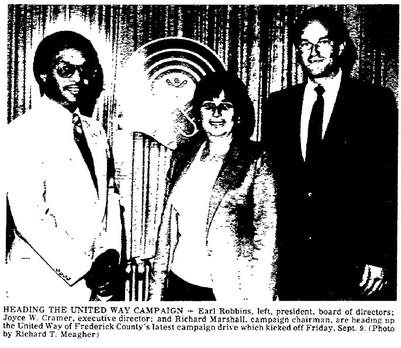 When the proverbial smoke cleared in early 1984, it was determined that the 1983 campaign raised $552,254. The new leadership team of Robbins, Marshall and Cramer had done it, of course with the help of determined volunteers and countless others. At a banquet in February, 1984, Robbins commented: “The practice of neighbor helping neighbor has been rekindled in Frederick County. The enthusiasm and success generated in the 1983 campaign has been heartwarming. God bless all the givers in Frederick County.” A year later, the goal was increased by 45% to $800,000. The rationale rested in the belief that the campaign should raise the true total needed for budgets by the 26 partner agencies under the United Way umbrella. The campaign fell short of its intended goal by raising only $700,000. However, this was still nearly $150,000 in additional funds raised than the previous year.  Frederick News (Sept 3, 1985) Frederick News (Sept 3, 1985) Our United Way Celebrity The 1985 campaign included another increase of the desired drive goal to $962,000 for the purpose of covering 22 local agencies. The official kick-off of the campaign included a varied entertainment bill at the Weinberg Center for the Arts. WFMD’s Tommy Grunwell served as emcee on a night that included country music performed by Don Barnes and Debbie Williams, organ selections by Richard Kline, and the showing of two films produced by the United Way. Several hundred people turned out to honor a very special guest, Julie Bartee, a Brunswick resident who was the national spokesperson for the United Way. Miss Bartee was also a senior at Maryland School for the Deaf. She had originally played a role in the United Way’s documentary film “You Don’t Do It, It Won’t Get Done,” produced in 1971. At the time, Julie was two years-old and living with her family in Nashville, Tennessee. The film showed how Julie’s parents, Robert and Gina Bartee, received help in diagnosing their daughter’s deafness through the Bill Wilkerson Hearing and Speech Center, an agency funded by the United Way. Country music legend Loretta Lynn helped tell the story. After receiving help, the Bartee family was urged to move to Frederick County to be near the Maryland School for the Deaf. Earlier in the year (1985), Loretta Lynn was called on to take part in a new film entitled “Memories,” in which Julie Bartee’s story was revisited 14 years later, sharing Julie’s academic success, and athletic prowess as an-award-winning track and field competitor who set several national records. Future United Way president, and current MSD Superintendent, Dr. David M. Denton introduced Miss Bartee as “a special person who strived to do her best.” Julie would give a speech in sign language retorting, “United Way was there when I needed their support.” She would continue to travel the country as an ambassador for the United Way during her year as spokesperson. The "hometown girl's" rise to prominence would have a very positive effect on elevating the message of the local organization. The following February of 1986, the entire Bartee family was lauded by the United Way of Frederick with the Volunteer of the Year award. Tommy Grunwell was also given special recognition for his generous help with the fund drive which netted $816,817. The goal would be raised to top the million-dollar mark a year later.  By the mid-80s, developing countries across the world faced economic and social difficulties as they suffered from multiple debt crises requiring many (of these countries) to apply for financial assistance from the International Monetary Fund (IMF) and the World Bank. Ethiopia witnessed widespread famine in the mid-1980s due to corrupt rulers, resulting in the country's dependence on foreign aid to provide food to its population, along with worldwide efforts to address and raise money such as the Live Aid Concert in 1985. Pop music had done some “out of the box” fundraising of its own, inspiring new ideas and avenues for addressing needs. From a global health perspective, The AIDS epidemic had become recognized as a killer of millions. Over the next three decades it would be responsible for taking the lives of nearly 40 million people.  In the 1980s, some of the momentum of education reform moved from the left to the right, with the release of “A Nation at Risk,” Ronald Reagan's efforts to reduce or eliminate the United States Department of Education. In the latter half of the decade, E. D. Hirsch put forth an influential attack on one or more versions of progressive education, advocating an emphasis on "cultural literacy"—the facts, phrases, and texts that Hirsch asserted every American had once known and that now only some knew, but was still essential for decoding basic texts and maintaining communication. After high tension for most of a decade, 1988 marked much improved relations between the US and Soviet Union. A decade that began with US residents getting to watch a miraculous ice hockey victory over the Russians in the 1980 Winter Olympics, now was coming to a close with images of the infamous Berlin Wall being toppled.  Digital technological advances ushered in the era of compact discs and digital video discs (dvds), changing entertainment delivery and quality for the better. Cable television was providing expansive offerings in entertainment, sports and news options. The global Internet had taken shape in academic settings such as college campuses by the second half of the 1980s, as well as many other computer networks of both academic and commercial use. By 1989, the Internet and the networks linked to it were a global system—quickly leading to the World Wide Web created by Sir Tim Berners-Lee. The latter half of the decade saw additional gifted community leaders guiding United Way of Frederick County and the annual appeals. State Farm's Deputy Regional VP Charles L. Snyder served as president in 1985 and was followed by Robert E. Clark, president of John Hanson Savings (1986). James D. Latimer, eastern division manager for Potomac Edison, headed the UWFC in 1987 and David M. Denton, Superintendent of the Maryland School for the Deaf, took charge in 1988. Under Denton's presidency, two more partner agencies joined the United Way—The American Cancer Society, and DILA (Deaf Independent Living Association). Going for Gold 1988 marked a very special year for the United Way of Frederick County as it was a landmark anniversary in which the organization would celebrate its 50th. Going back to 1938 and the Community Chest, special brochures and posters had been produced by volunteers for each annual campaign. This commemorative year was no different as Charlene Hennessy of IronGate Graphics designed the theme and poster for 1988 entitled "Going for Gold." The poster depicted the spirit of the Olympic Games with marathon runners moving ahead with the strength and determination to make the finish line. A lofty goal of $1,800,00 was set for this hallmark year. This was considerably larger than the previous year's (1987) projected intake of $1,177,476 (of which only $952, 850 was collected). A special kickoff breakfast was held on September 16th at the FSK Holiday Inn Frederick. Immediately following breakfast, a celebratory motorcade had been arranged which took participants northward from the hotel (located just off MD85/Buckeystown Pike) to Downtown Frederick via Market Street. The grand marshal for the event was Frances Randall, part owner of the Frederick News-Post and niece of the Frederick Community Chest's inaugural 2nd VP, William T. Delaplaine. Mrs. Randall had served as a longtime guiding light for the Girl Scouts of Frederick, a charter partner-agency with the organization dating to 1938. The motorcade ended at the Big Brothers/Big Sisters office on N. Market Street, located within the Odd Fellows Home. Along the route, representatives from all 20 agencies of the UWFC waved banners, flew balloons and cheered on the vehicles with a chant of "Go for Gold!" The 1988 anniversary campaign brought in $1,238,00. This was only 69% of the desired goal, however, it was a $286,000 improvement on 1987's sum and the first time in Frederick history that the annual appeal would break the "million-dollar mark." After the excitement of the anniversary year waned, another major transition would beset the United Way's Frederick Chapter. Executive Director Joyce Cramer retired in June, 1989. Over her seven-year tenure, the number of volunteers had jumped from 200-500. Annual contributions followed suit going from $350,000 to over $1,200,000. The departure of Mrs. Cramer opened the door for a new executive director in the person of Nancy Crum. Crum formerly held the position of assistant director of the UWFC, and was a natural choice to serve as acting executive director in Cramer’s absence. She would soon become executive director and hold the post for five years. A group of doctors in education helped lead the United Way of Frederick County from the mid 1980’s into the 1990’s. These included the fore mentioned Dr. David Denton (Maryland School for the Deaf) and Dr. John George (Frederick County Public School teacher and elementary history curriculum head) and Dr. Michael Cohen (former principal of Lewistown Elementary). The educational and communicative talents of these gentlemen would certainly be put to the test at the start of the next decade as unforeseen trouble was brewing. The National Scandal Michael Cohen was serving as United Way of Frederick County president in February, 1992 amidst a grim economy. To add insult to injury, this was also the same period that a national media story surfaced involving impropriety and financial mismanagement within the national United Way organization. The scandal was focused on William Aramony, CEO of the national United Way for over 20 years. The story was broke by investigative columnist Jack Anderson. Aramony would retire in 1992 amid allegations of fraud and financial mismanagement, of which he was subsequently convicted. He was sentenced to seven years in prison and fined $300,000. While many United Way chapters throughout the country scrambled to combat “guilt by association,” United Way of Frederick County was able to stand confident and “educate” the community about its own track record, fiduciary practices and the integrity of its leadership and general membership of volunteers from throughout the county. UWFC members wanted the masses and, most importantly, campaign contributors to understand that their local campaign donations stayed local, and had been properly appropriated to local agency partners. Board President Michael Cohen, a native of Brooklyn, NY had come to Frederick in 1976 and worked as a supervisor of elementary schools. He had also formerly served as director of the Frederick March of Dimes and as a Board member of the ARC of Frederick County. He addressed the many concerns raised with a heartfelt and poignant commentary in the Frederick News-Post dated February 26th, 1992. The letter was signed by the 31 members of the UWFC Board and staff, showing their professional affiliations and unity to the continued cause at hand.
 Frederick Post (Oct 21, 1994) Frederick Post (Oct 21, 1994) Countering Grungy Times Culturally, the 1990’s are characterized by the rise of multiculturalism and alternative media, which continued into the 2000’s. The term “grunge” became popular during this time, first used to describe the murky-guitar bands that emerged from Seattle and the northwest part of the country such as Nirvana and Pearl Jam. Bands weren’t the only things “grungy,” during this time. The United Way brand had taken a major hit, and was now perceived by many as dirty and unkempt. The scandal wasn’t through playing out in the national media. Just days after the 1993 campaign kicked off here locally in October of 1993, more national news came out about the misuse of funds by William Aramony and other national UW staffers. The scandal would subside as the new governance structure implemented at United Way of America became a model for the nonprofit sector. Following the presidency of Dr. Michael Cohen, Richard Roschli (Potomac Edison's eastern division manager) was charged with leading the organization into brighter times. Now more than ever, a strong public relations effort, as well as positive marketing, was needed at the local level to dispel rumor and misconceptions. Susan Shreve, a staffer at the US Treasury Department was hired to handle a newly created position as UWFC’s Marketing and Communications Director. Another proactive move occurred as the next four years leading up to the 60th anniversary of the organization seemed to feature professional leadership individuals that were "ultra-responsible" with handling money and garnering community support.  Ramona C. Remsberg Ramona C. Remsberg The fore-mentioned Ramona Corun Remsberg was a native of Jefferson (MD) and former president of Frederick County National Bank. She spent 55 years at FCNB and holds the distinction of being the first female in Frederick history to hold a chief position at a local financial institution. Mrs. Remsberg would serve two terms as UWFC campaign chair in 1992 & 1993 and Board president 1994 & 1995. She is fondly remembered today as one of the most dynamic leaders ever to grace the organization. Many recall that Ramona Remsberg positively influenced volunteers and donors alike to give more of themselves and their donation for the good of the community. She would be followed as Board president by R. Michael Menzies of 1st Bank of Frederick. September 14, 1995 marked the kickoff of the 1995 campaign. The stage was set for United Way of Frederick County’s first ever “Day of Caring” event. This featured 210 volunteers from 30 businesses, adorned in United Way t-shirts and participating in 40 community service projects around the county. The event gave volunteers a first-hand view of the everyday work done by partner agencies. They also got to see their hard-earned contributions at work.  Joseph D. Baker Joseph D. Baker For additional coverage during this fragile time, insurance expert Joseph D. Baker would chair the campaign in 1996 and serve as president in 1997 and 1998. You could say that Baker also had fiscal knowledge in his blood as his namesake grandfather helped organize three different Frederick banks over his lifetime. As was stated at the onset, the elder Joseph D. Baker knew a bit about philanthropy as well. Executive Director Nancy Crum had left the UWFC in 1996. Her replacement was Charles Riddle who came from Sagamon County, Illinois where he was involved with the local United Way of that place for 22 years. Riddle stayed in Frederick for only 10 months before tendering his resignation in April 1997. Current UWFC Board Vice-President Susie Loveland was quickly appointed as acting executive director. Loveland was co-campaign chair the previous year, and had served as organization president of the Berkeley County United Way from 1986-1990 before coming to Frederick to take up employment as Public Relations Director for Frederick Community College. In 1998, President Baker, along with his campaign chair, Dr. Ann Boyd, a biology professor at Hood College, kicked off the 60th year of "federated and united giving" in the area. Although not as grand as the 50th commemoration a decade previously, Acting Executive Director Susie Loveland worked diligently on a fine campaign to celebrate the United Way of Frederick County's "Diamond Jubilee."
The United Way had weathered a major storm on both the national and local levels. It was time for celebration, and a renewed commitment to the mission at hand as the world was readying to move into the new millennium. The mission of the 60-year-old organization was still as it always had been--to maximize community support to meet the human service needs of Frederick County.
0 Comments
Leave a Reply. |
AuthorChris Haugh Archives
February 2024
Categories |
Proudly powered by Weebly




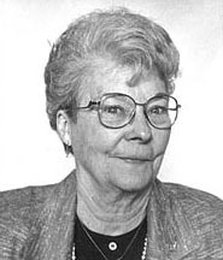












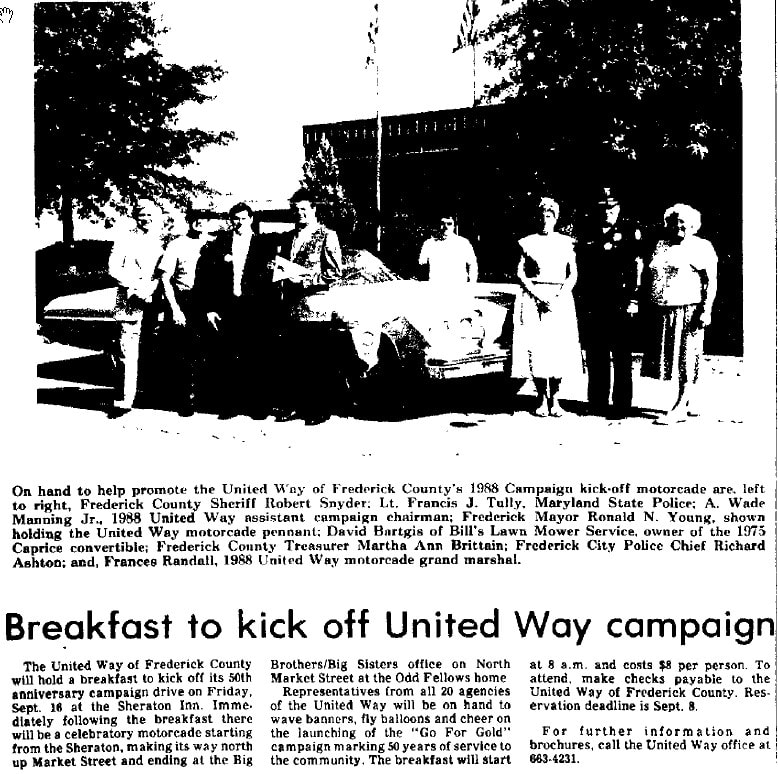

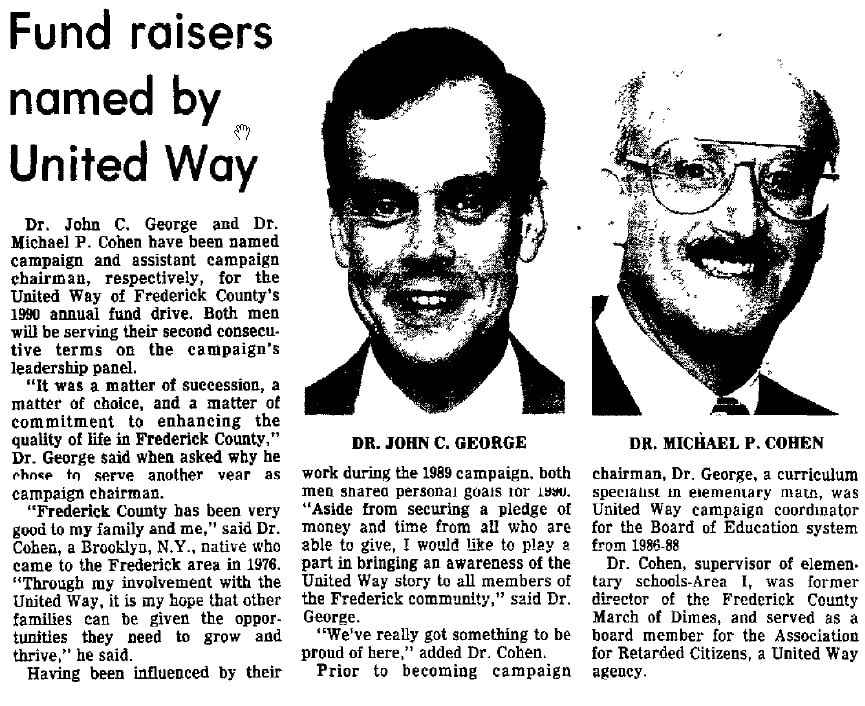





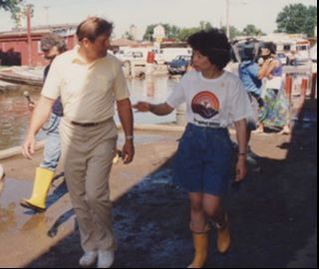



 RSS Feed
RSS Feed